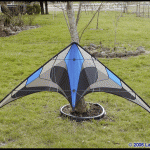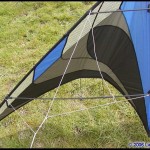 Specifications
Specifications
Manufacturer: HQ Kites
Model: Gallego and Gallego Supreme
Wingspan: 94″ (Gallego) 96″ (Supreme)
Height: 41.5″
Weight: 340g (Gallego) 328g (Supreme) Type of kite: Ballet kite
Materials: Ventex and Mylar, Dynamic T18, Skyshark P200 and Avia .230.
Source for test kite: Manufacturer
Suggested Retail : $184.99 (Gallego) $279.99 (Supreme)
Quality of Construction
The sail has a total of 25 panels using a mix of Ventex and Mylar panels on the Supreme (shown in blue), whereas the Gallego (shown in green) uses just the Ventex. The seams are all taped and zig-zag stitched, giving it a sturdy appeal. There are dacron LE covers on the upper spreader connectors for the jo-jo glides for both models. The standoff for the winglet are sewn into the sail so you don’t have to worry about losing them, as one tends to do with so many other winglet kites. The sail workmanship is quite good and I could not really find any problem areas to point out.
I did however have some issues with the framing quality and fit on the samples we received for testing. We found the standoff end caps a bit too large for the spreader standoff connectors so they would get stuck in the connector, or not seat very well.
Also, the weight option included with the Supreme they provided to us for testing had used a fiberglass plugged Sky Shark P200 to a ferruled section that is removable… In order to install the weight we had to remove the original rubber stopper that was glued on, then the weight did not fit because the fiberglass was too large for the hole drilled into the weight.
However, since we picked up these kites for testing in January, HQ Kites has changed these removable sections to a .230 Avia rod on which both weights apparently fit quite well.
The Gallego Supreme is outfitted with wrapped Dynamic T18 lower spreaders which while making for a decent frame, depending on your geography, may be more difficult to acquire than other rods in the event of repair.
Bridle
The bridle is a reverse turbo affair with a keeper line to avoid any tail wraps that could occur. However I did notice that due to the length of this bridle that it will occasionally get caught around the yo-yo stops during multilazies in particular, thwarting that trick occasionally.
Design Features and Tuning
There is a leech line adjustment system on the back between the velcro spine release and the center T. The sail standoff connectors are covered and clean for no snags, also mylar reinforced on the supreme.
The Gallego uses the trailing edge foldover sail standoff clips, they do make for some good line snags. The sail in the standoff area is reinforced with just enough dacron to mitigate wear and tear from flying rolled up… The Gallego Supreme uses a covered trailing edge which effectively covers the stand off clips, avoiding those annoying snags.
The fittings all appear to be HQ’s own designs. They have also designed their own unique yo-yo (“Jojo”) stoppers, which at first glance appear to be a “one size fits all” LE snap on style of stopper. The ones that came with these kites are particularly difficult to put onto a Sky Shark P200 leading edge due to it’s diameter. I would also recommend either taping or gluing these stoppers in place because they will have a tendency to pop off on their own or work loose during roll-up maneuvers, a relatively minor modification will keep them in place.
Yo yo stops are available from HQ Kites in sizes of 4, 5mm, 6mm and 8 mm, they can also be purchased separately. The Gallego comes with 6mm Jojo Stoppers (both models).
Wind Range
The advertised wind range is 4 to 24 mph on the Supreme and 4 to 18 mph for the Gallego… However, I would say that they require a good 5 mph for a really solid day of flying.
Amount of Pull and Sensitivity
The Gallego’s produce moderate speed and pull. They will also turn within their wingtips and quickly I may add which is reminiscent of HQ’s first version Maestrale. As a result of this ability to quickly turn, there is certainly some oversteer incorporated into the design. This also translates into requiring much smaller hand movements to snap to your next line. The Gallego’s also have a slightly heavier feel on the lines than some other kites in their size range. Unusual Flight Behaviors
Surprisingly enough for a kite of this size and aspect ratio, it will do roll-ups with or without weight. On the downside I find that the Gallego struggles to do Jacobs Ladders with any reliable consistency, as it usually ends up half way into the ladder for the return to fade and the trailing edge just wants to slide back towards the flyer. Strongest Tricks
I found that insanes and multilazies are the Gallego’s stronger tricks. Also flat spin tricks are one of it’s stronger area which it obviously received from it’s Tramontana heritage, although it does take some good technique and wind to get really good ones. The kite will backspin, although I thought the Gallego looked more graceful at doing multilazies than backspins. The Gallego’s will do yo-yo’s front or back, although I would personally add additional stoppers if you plan on doing a fair amount of roll ups.
Most Challenging Tricks
As mentioned earlier the Gallego’s had difficulty with Jacobs Ladders during our test flights, and I found that adding weight seems to compound the problem. Also, Flic-Flacs take a hit in repeatability because of the return to fade issue with the kite wanting to slide back towards the flyer when coming out of the pancake… This might be overcome by hitting it a little earlier, before the kite goes completely flat. The Gallego’s do not seem to be very stable in the fade, as the kites we tested would not hold it for very long before the nose dipped out.
Precision (corners, tracking, speed)
The Gallego’s precision was better than I expected given the oversteer that I noticed. Not much hand movement is needed to snap to your next line. The speed remains moderate and controllable even in higher winds. The Gallego standard tends to bobble a little in the turns because of the pultruded frame although it turns so quickly when you hit a quick combo turn, that it will compensate for it and you may not notice. The quickness at which it goes to the next line is sort of addictive, and a lot of fun.
Similarities and Differences to Other Kites
The speed at which the Gallego turns reminds me of the first HQ Maestrale although the Gallego has stuffed a few more tricks into it’s repertoire than it’s predecessor’s. The Gallego’s flat spin abilities are also reminiscent of the Tramontana’s.
Flying Experience
In my flying, a few of the positive things I noted are how little effort it takes to snap a turn and not that much more force to end up in a backflip which makes for easily sticking some nice two point landings. The multilazies and snap-lazies are quite good for a kite that has a fairly low aspect ratio, and the rotations are nice looking, they look much better than the backspin rotations.
On the negative side I found the inconsistent Flic-Flacs and Jacobs Ladders very frustrating when the back of the kite just wants to slide back towards the flyer. I feel the backspin lacks grace and consistency.
The Gallego Supreme comes with a 15 gram weight, although I actually preferred flying it without the weight and it seemed to trick overall a little better without it… Of course, the yo-yo’s require a little more effort but are still doable. You have a fair amount of mass to work with when executing flat spin tricks and cascades.
Summary
The Gallego is marketed as an all around ballet kite that can do all of the old school and new school tricks “with ease”. With the current level of new tricks being added to today’s ballet routines, in my opinion I think the Gallego misses the mark on some of the new school tricks, although it will likely satisfy many of the old school fliers not looking to do every slack line trick in the book.
The Gallego does not appear to come in a full competition set as of this writing (vent, UL, etc), so that makes it a tougher sell as a competition ballet kite. However if you can live with some of the Gallego’s shortcomings in the slack line department, then they might very well appeal to you.
Review and photos by Lance Storr
















